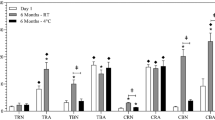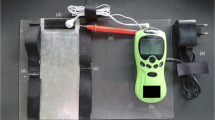Abstract
Objective of the study was to design an injectable microsphere preparation with high drug loading of bupivacaine for prolonged release and local anesthetic. PLA or PLGA was used as the biodegradable matrix material to fabricate microspheres with the o/w emulsification-solvent evaporation method. The characterization of bupivacaine microspheres was observed by SEM, DSC, and XRPD. The microsphere preparation and extended drug release, as well as the plasma drug concentration and sciatic nerve blockade after injection of the microsphere formulation to rats were investigated. High drug-loading microspheres of more than 70% were successfully obtained with extended drug release over 5 days in vitro depending on the type of matrix and the feed ratio of drug to polymer. SEM, DSC, and XRPD results verified a novel microsphere structure characterized as the porous core composed of PLA material and form II bupivacaine crystals and dense shell formed of PLA layer. The mechanism that bupivacaine was dissolved inside the microsphere and diffused across the dense shell was suggested for drug release in vitro. The optimized PLA microsphere formulation showed low and steady plasma drug concentration over 5 days and prolonged duration of sensory and motor blockade of sciatic nerve lasted more than 3 days. Results indicated that the porous core-shell structure of PLA microsphere formulation would provide enormous potential as an injectable depot for locally prolonged delivery of bupivacaine and control of postoperative pain.







Similar content being viewed by others
References
Bramlett K, Onel E, Viscusi ER, et al. A randomized, double-blind, dose-ranging study comparing wound infiltration of DepoFoam bupivacaine, an extended-release liposomal bupivacaine, to bupivacaine HCl for postsurgical analgesia in total knee arthroplasty. Knee. 2012;19(5):530–6.
Cusack SL, Jaros M, Kuss M, Minkowitz HS, Winkle P, Hemsen L. Clinical evaluation of XaraColl((R)), a bupivacaine-collagen implant, for postoperative analgesia in two multicenter, randomized, double-blind, placebo-controlled pilot studies. J Pain Res. 2012;5:217–25.
Ellis D, Verity N, Lissin D, et al. Treatment of postoperative pain in shoulder surgery with SABER-Bupivacaine. J Pain. 2013;14(4):S84.
Chen PC, Park YJ, Chang LC, Kohane DS, Bartlett RH, Langer R, et al. Injectable microparticle-gel system for prolonged and localized lidocaine release. I. In vitro characterization. J Biomed Mater Res A. 2004;70(3):412–9.
P C Chen, Kohane D S, Park Y J, Bartlett R.H., Langer R., Yang V.C., Injectable microparticle-gel system for prolonged and localized lidocaine release. II. In vivo anesthetic effects. J Biomed Mater Res A, 2004. 70(3): p. 459–466.
L L., J. Q, B. S, et al., Intrathecal dexmedetomidine can decrease the 95% effective dose of bupivacaine in spinal anesthesia for cesarean section: a prospective, double-blinded, randomized study. Medicine (Baltimore), 2019. 98(9).
Fu Y, Kao WJ. Drug release kinetics and transport mechanisms of non-degradable and degradable polymeric delivery systems. Expert Opin Drug Deliv. 2010;7(4):429–44.
R Rc., Pj. S, Wg. C, et al., Handbook of Pharmaceutical Excipients 7ed. 2012, London : Pharmaceutical Press.
Tian L, Gao J, Yang Z, et al. Tamibarotene-loaded PLGA microspheres for intratumoral injection administration: preparation and evaluation. AAPS PharmSciTech. 2018;19(1):275–83.
Di W, Czarny RS, Fletcher NA, et al. Comparative study of poly (epsilon-Caprolactone) and poly(lactic-co-glycolic acid)-based nanofiber scaffolds for pH-sensing. Pharm Res. 2016;33(10):2433–44.
Xu Y, Kim CS, Saylor DM, et al. Polymer degradation and drug delivery in PLGA-based drug-polymer applications: a review of experiments and theories. J Biomed Mater Res B Appl Biomater. 2017;105(6):1692–716.
Park K, Skidmore S, Hadar J, Garner J, Park H, Otte A, et al. Injectable, long-acting PLGA formulations: analyzing PLGA and understanding microparticle formation. J Control Release. 2019;304:125–34.
Li W, He B, Dai W, et al. Evaluations of therapeutic efficacy of intravitreal injected polylactic-glycolic acid microspheres loaded with triamcinolone acetonide on a rabbit model of uveitis. Int Ophthalmol. 2014;34(3):465–76.
Schwendeman SP, Shah RB, Bailey BA, Schwendeman AS. Injectable controlled release depots for large molecules. J Control Release. 2014;190:240–53.
Wang JW, Xu JH, J. L. Administration of cucurbitacin PLGA microspheres incorporated in in situ-forming SAIB depots. J Pharm Sci. 2015;105(1):205–11.
Zhang Y, Chan HF, Leong KW. Advanced materials and processing for drug delivery: the past and the future. Adv Drug Deliv Rev. 2013;65(1):104–20.
S Yy. and Pl. M, An updated review of its use in type 2 diabetes mellitus. Drugs, 2015. 75(10): p. 1141–1152.
Rodriguez Villanueva J, Bravo-Osuna I, Herrero-Vanrell R, et al. Optimising the controlled release of dexamethasone from a new generation of PLGA-based microspheres intended for intravitreal administration. Eur J Pharm Sci. 2016;92:287–97.
A Rawat, Bhardwaj U, and Burgess D J, Comparison of in vitro-in vivo release of Risperdal((R)) Consta((R)) microspheres. Int J Pharm, 2012. 434(1–2): p. 115–121.
Citrome L. New second-generation long-acting injectable antipsychotics for the treatment of schizophrenia. Expert Rev Neurother. 2013;13(7):767–83.
Duarte AR, Unal B, Mano JF, et al. Microfluidic production of perfluorocarbon-alginate core-shell microparticles for ultrasound therapeutic applications. Langmuir. 2014;30(41):12391–9.
Zeng H, Pang X, Wang S, et al. The preparation of core_shell structured microsphere of multi first-line anti-tuberculosis drugs and evaluation of biological safety. Int J Clin Exp Med. 2015;8(6):8398–414.
Xu Q, Chin SE, Wang CH, et al. Mechanism of drug release from double-walled PDLLA(PLGA) microspheres. Biomaterials. 2013;34(15):3902–11.
Falconi M, Focaroli S, Teti G, et al. Novel PLA microspheres with hydrophilic and bioadhesive surfaces for the controlled delivery of fenretinide. J Microencapsul. 2014;31(1):41–8.
Cui F, Yang M, Jiang Y, et al. Design of sustained-release nitrendipine microspheres having solid dispersion structure by quasi-emulsion solvent diffusion method. J Control Release. 2003;91(3):375–84.
Pek YS, Pitukmanorom P, Ying JY. Sustained release of bupivacaine for post-surgical pain relief using core–shell microspheres. J Mater Chem B. 2014;2(46):8194–200.
Zhang W, Ning C, Xu W, et al. Precision-guided long-acting analgesia by hydrogel-immobilized bupivacaine-loaded microsphere. Theranostics. 2018;8(12):3331–47.
Bragagni M, Gil-Alegre ME, Mura P, et al. Improving the therapeutic efficacy of prilocaine by PLGA microparticles: preparation, characterization and in vivo evaluation. Int J Pharm. 2018;547(1–2):24–30.
Okada H. One- and three-month release injectable microspheres of the LH-RH superagonist leuprorelin acetate. Adv Drug Deliv Rev. 1997;28:43–70.
Solaric M, Bjartell A, Thyroff-Friesinger U, et al. Testosterone suppression with a unique form of leuprorelin acetate as a solid biodegradable implant in patients with advanced prostate cancer: results from four trials and comparison with the traditional leuprorelin acetate microspheres formulation. Ther Adv Urol. 2017;9(6):127–36.
Ramazani F, Chen W, Van Nostrum CF, et al. Strategies for encapsulation of small hydrophilic and amphiphilic drugs in PLGA microspheres: State-of-the-art and challenges. Int J Pharm. 2016;499(1–2):358–67.
Da Silva GHR, Ribeiro LNM, Mitsutake H, et al. Optimised NLC: a nanotechnological approach to improve the anaesthetic effect of bupivacaine. Int J Pharm. 2017;529(1–2):253–63.
Rodrigues Da Silva GH, Geronimo G, Ribeiro LNM, et al. Injectable in situ forming nanogel: a hybrid Alginate-NLC formulation extends bupivacaine anesthetic effect. Mater Sci Eng C Mater Biol Appl. 2020;109:110608.
Da HK, Yoo JY, Ko YS. L-Lactide ring-opening polymerization with Tris(acetylacetonate)Titanium(IV) for renewable material. J Nanosci Nanotechnol. 2016;16(5):4539–43.
Kojima R, Yoshida T, Tasaki H, et al. Release mechanisms of tacrolimus-loaded PLGA and PLA microspheres and immunosuppressive effects of the microspheres in a rat heart transplantation model. Int J Pharm. 2015;492(1–2):20–7.
Bergström JS, Hayman D. An overview of mechanical properties and material modeling of polylactide (PLA) for medical applications. Ann Biomed Eng. 2016;44(2):330–40.
Curley J, Castillo J, Hotz J, Uezono M, Hernandez S, Lim JO, et al. Prolonged regional nerve blockade. Injectable biodegradable bupivacaine polyester microspheres. Anesthesiology. 1996;84:1401–10.
Rawat A, Bhardwaj U, Burgess DJ. Comparison of in vitro-in vivo release of Risperdal(®) Consta(®) microspheres. Int J Pharm. 2012;434(1–2):115–21.
Andhariya JV, Shen J, Choi S, Wang Y, Zou Y, Burgess DJ. Development of in vitro-in vivo correlation of parenteral naltrexone loaded polymeric microspheres. J Control Release. 2017;255:27–35.
P L Corre, Este’Be. J P, Cle’Ment. R, et al., Spray-dryed bupivacaine-loaded microspheres in vitro evaluation and biopharmaceutics of bupivacaine following brachial plexus administration in sheep. Int J Pharm, 2002. 238: p. 191–203
Curley J, Castillo J, Hotz J, et al. Prolonged regional nerve blockade. Injectable biodegradable bupivacaine polyester microspheres. Anesthesiology. 1996;84:1401–10.
Acknowledgments
Materials support from Dr. Z. Tang at Changchun Institute of Applied Chemistry is gratefully acknowledged.
Funding
This work was financially supported by the Development Supporting Program for Young and Middle-aged Teachers of Shenyang Pharmaceutical University and by the Financially Supported Project to Competitive Industries from Shijiazhuang Development and Reform Commission (No. 2159999).
Author information
Authors and Affiliations
Corresponding authors
Additional information
Publisher’s Note
Springer Nature remains neutral with regard to jurisdictional claims in published maps and institutional affiliations.
Supplementary Information
ESM 1
(DOC 40 kb)
Rights and permissions
About this article
Cite this article
Xu, J., Bai, Y., Li, X. et al. Porous Core/Dense Shell PLA Microspheres Embedded with High Drug Loading of Bupivacaine Crystals for Injectable Prolonged Release. AAPS PharmSciTech 22, 27 (2021). https://doi.org/10.1208/s12249-020-01878-8
Received:
Accepted:
Published:
DOI: https://doi.org/10.1208/s12249-020-01878-8




